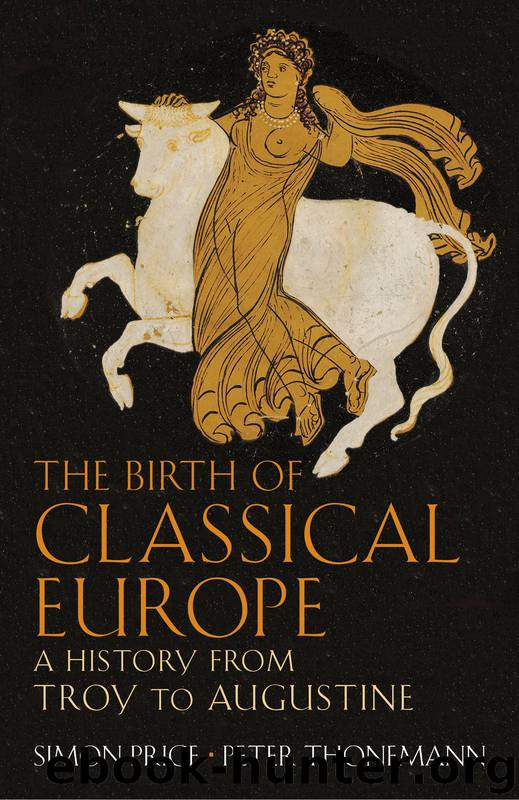The Birth of Classical Europe by Simon Price

Author:Simon Price
Language: eng
Format: epub
ISBN: 9780141946863
Publisher: Penguin Books Ltd
Published: 2010-03-25T16:00:00+00:00
Carthage has so far made only cameo appearances in the story. It is time to redress the balance, and to start analysis of the relations between Carthage and Rome with some consideration of how Carthaginians saw themselves. We need to try to escape from the viewpoint of the Roman victors, which inevitably depicted the Carthaginians negatively. Carthage, founded from Tyre in Phoenicia probably in the late ninth century BC, was situated on a spit of land jutting out into the sea. Like other Phoenician colonies of the period, it was well positioned to make the most of trade routes. The archaic settlement covered 25 hectares, or even 45–60 hectares on some estimates, which would place Carthage among the larger Mediterranean towns of the sixth century BC. Its walls are said to have been 37 kilometres long, more than three times the length of Rome’s walls at this time. Its harbour was important from the outset, and Carthage had important trading interests in the central and western Mediterranean. From the fifth century BC onwards Carthage made military interventions in Sicily, and from the fourth century BC controlled the coast of North Africa from Cyrene in the east to the Atlantic in the west. The settlements along the coast were probably tied to Carthage by individual alliances, somewhat like relations between the Latins and Rome.
Carthage saw itself as a city with a Phoenician past and a Phoenician present. According to stories recounted by Greek and Roman writers, but possibly based on Phoenician sources, as a result of struggles for power within Tyre a losing faction fled first to Cyprus and then to the site of Carthage. Here their leader, the princess Elissa, was allowed by the king of the local Libyans to found a new settlement (Carthage, Qart hadasht, means ‘New City’ in Phoenician). As the widow of Acherbas, priest of Melqart in Tyre, Elissa had brought with her objects sacred to Melqart, and founded a cult of Melqart at Carthage (Melqart, milk qart, means ‘King of the City’). Because the Libyan king demanded that she marry him, Elissa, faithful to her late husband, killed herself by throwing herself on a pyre. The story of a foundation from Tyre was mirrored in ritual. Each year the Carthaginians sent tribute to the temple of Melqart at Tyre. In 332 BC, when Alexander the Great was besieging Tyre, he happened to capture the Carthaginian envoys who had brought the annual tribute to Melqart, and he dedicated their sacred ship to the deity whom he called Heracles. Tyre’s subsequent loss of political freedom did not break the ties with Carthage, and the annual tribute continued until the destruction of Carthage in the second century BC.
In addition, rituals of Phoenician origin were performed at Carthage. Overlooking one of the city’s harbours, Carthage had an open-air sanctuary, in which were buried vessels with the cremated remains of newborn babies and young children, or sometimes animals. The sanctuary is called a ‘tophet’ today, but this term, borrowed from the Hebrew Bible, was probably not that used by the Carthaginians.
Download
This site does not store any files on its server. We only index and link to content provided by other sites. Please contact the content providers to delete copyright contents if any and email us, we'll remove relevant links or contents immediately.
The Daily Stoic by Holiday Ryan & Hanselman Stephen(3235)
The Fate of Rome: Climate, Disease, and the End of an Empire (The Princeton History of the Ancient World) by Kyle Harper(3003)
People of the Earth: An Introduction to World Prehistory by Dr. Brian Fagan & Nadia Durrani(2701)
Ancient Worlds by Michael Scott(2625)
Babylon's Ark by Lawrence Anthony(2620)
The Daily Stoic by Ryan Holiday & Stephen Hanselman(2459)
Foreign Devils on the Silk Road: The Search for the Lost Treasures of Central Asia by Peter Hopkirk(2434)
India's Ancient Past by R.S. Sharma(2416)
MOSES THE EGYPTIAN by Jan Assmann(2373)
The Complete Dead Sea Scrolls in English (7th Edition) (Penguin Classics) by Geza Vermes(2235)
Lost Technologies of Ancient Egypt by Christopher Dunn(2194)
The Earth Chronicles Handbook by Zecharia Sitchin(2180)
24 Hours in Ancient Rome by Philip Matyszak(2050)
Alexander the Great by Philip Freeman(2033)
Aztec by Gary Jennings(1975)
The Nine Waves of Creation by Carl Johan Calleman(1884)
Curse Tablets and Binding Spells from the Ancient World by Gager John G.;(1838)
Before Atlantis by Frank Joseph(1811)
Earthmare: The Lost Book of Wars by Cergat(1790)
